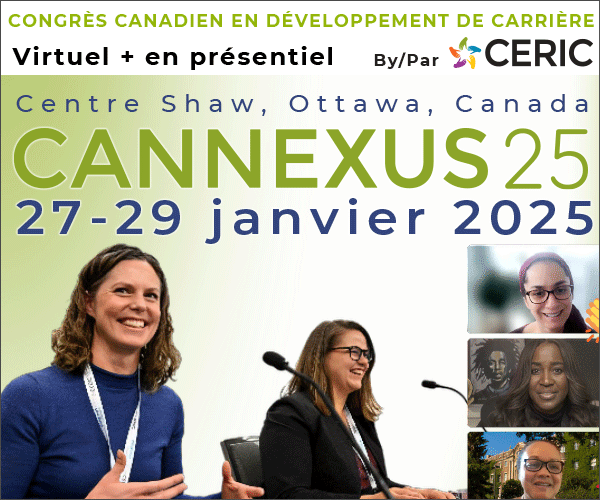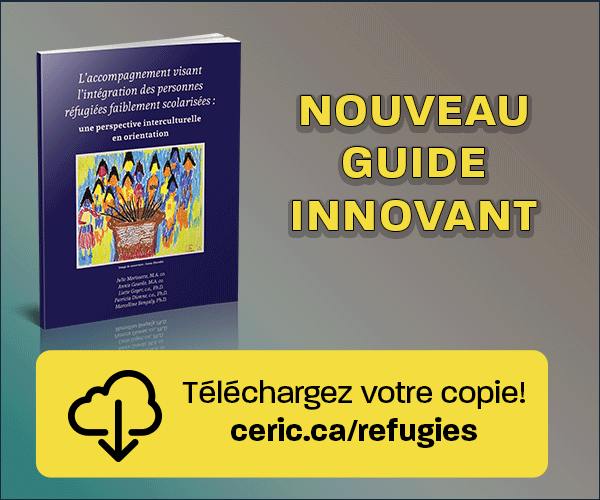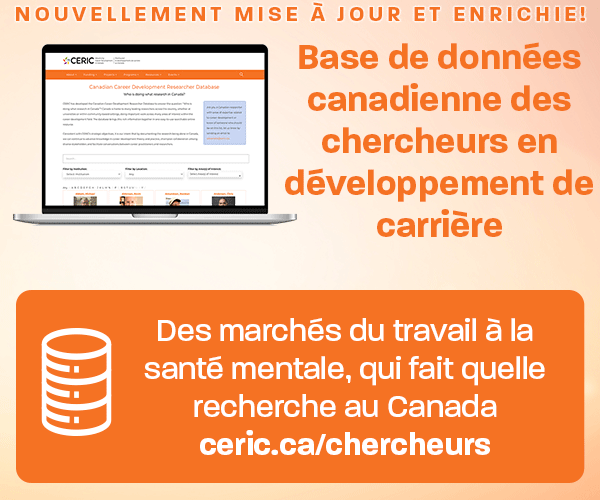Ce qui aide et ce qui mine l’espoir des étudiants de niveau postsecondaire qui ont connu d’importants obstacles à l’emploi
Mots-clés :
post-secondaire, étudiants, barrières, espoirRésumé
Cette étude avait pour bud’examiner les conditions dans lesquelles, les étudiants de premier cycle au Canada et aux États-Unis, face aux épreuves à surmonter, ressentent un fort espoir, en particulier lorsqu’ils sont confrontés à ces défis, et c’est spécifiquement ce qui favorise ouentrave, leur espérance. Nous avons employé une méthode améliorée des incidents critiques, comprenant des entrevues tour à tour en profondeur et semi-structurées, donnant lieu à des questions ouvertes et également à des questions de clarification. Pour ce faire, nous avons interrogé un panel de quinze étudiants déclarant à la fois éprouver de vifs espoirs et être confrontés à de nombreux obstacles, afin de connaître leurs définitions respectives de l'espoir et également de déceler les facteurs qui ont favorisé ou freiné leur espérance. Les participants ont défini l’espoir comme un concept multidimensionnel dans lequel entrent en jeu des facteurs affectifs, cognitifs, comportementaux, affiliatifs, contextuels et temporels. 281 cas ont été étudiés et ces derniers ont révélé que des facteurs internes et environnementaux avaient influencé le niveau d'espérance.
Références
Amundson, N., Niles, S., Yoon, H. J., Smith, B., In, H., & Mills, L. (2013). Hope Centred Career Development for University/College Students, pp. 1-39. Retrieved from
http://www.ceric.ca/ceric/files/pdf/CERIC_Hope-Centered-Career-Research-FinalReport.pdf
Arnau, R. C., Rosen, D. H., Finch, J. F., Rhudy, J. L., & Fortunato, V. J. (2007). Longitudinal effects of hope on depression and anxiety: A latent variable analysis. Journal of Personality, 75(1), 43-64. doi: 10.1111/j.1467-6494.2006.00432.x
Avey, J. B., Patera, J. L., & West, B. J. (2006). The implications of positive psychological capital on employee absenteeism. Journal of Leadership and Organizational Studies, 13(2) 42-60. doi: 10.1177/10717919070130020401
Bandura, A. (1986). Social foundations of thought and action: A social cognitive theory. New York, NY: Prentice Hall.
Bryant, F. B., & Cvengros, J. A. (2004). Distinguishing hope and optimism: Two sides of a coin, or two separate coins? Journal of Social and Clinical Psychology, 2(2), 273-302. doi: 10.1521/jscp.23.2.273.31018
Cheavens, J. S., Michael, S. T., & Snyder, C. R. (2005). The correlates of hope: psychological and physiological benefits. In J. A. Elliot (Ed.), Interdisciplinary Perspectives on Hope (pp. 119-132). Hauppauge, NY: Nova Science Publishers.
Combs, G. M., Clapp-Smith, R., & Nadkarni, S. (2010). Managing BPO service workers in India: Examining hope on performance outcomes. Human Resource Management, 49(3), 457– 476. doi:10.1002/hrm.20355
Conference Board of Canada. (2013). Innovation Skills Profile 2.0. Retrieved from http://www.conferenceboard.ca/cbi/innovationskills.aspx
Dufault, K. & Martocchio, B. C. (1985). Hope: Its spheres and dimensions. Nursing Clinics of North America, 20(2), 379-391.
Edey, W., & Jevne, R. F. (2003). Hope, illness and counselling practice: Making hope visible. Canadian Journal of Counselling and Psychotherapy/Revue canadienne de counseling et de psychothérapie, 37(1), 44-51. Retrieved from http://www.cjc-rcc.ucalgary.ca/cjc/index.php/rcc/article/view/221
Elliott, T. R., Witty, T. E., Herrick, S. M., & Hoffman, J. T. (1991). Negotiating reality after physical loss: hope, depression, and disability. Journal of Personality and Social Psychology, 61(4), 608-613. doi: 10.1037/0022-3514.61.4.608
Haase, J. E., Britt, T., Coward, D. D., Leidy, N. K., & Penn, P. E. (1992). Simultaneous concept analysis of spiritual perspective, hope, acceptance and self‐transcendence. Journal of Nursing Scholarship, 24(2), 141-147. doi: 10. 1111/j.1547-5069.1992.tb00239.x
Hall, D. T. (1996). Protean careers of the 21st century. The Academy of Management Executive, 10(4), 8–16. doi:10.5465/AME.1996.3145
Hanna, F. J. (2002). Building hope for change. In F. J. Hanna (Ed.), Therapy with difficult clients: Using the precursors model to awaken change (pp. 265-273). Washington, DC: American Psychological Association. Herth, K. (1993). Hope in older adults in community and institutional settings. Issues in Mental Health Nursing, 14(2), 139-156.
Hughes, J. R., Clark, S. E.,Wood, W., Cakmak, S., Cox, A., MacInnis, M., ... & Broom, B. (2010). Youth homelessness: The relationships among mental health, hope, and service satisfaction. Journal of the Canadian Academy of Child and Adolescent Psychiatry, 19(4), 274. Retrieved from http://www.ncbi.nlm.nih.gov/pmc/articles/PMC2962540/
Isenor, J. K. (2011). Exploring the impact of job loss as a function of grief, depression, optimism, hope and self-efficacy. (Unpublished master’s thesis). University of Western Ontario, London, ON.
Karabanow, J., Hughes, J., Ticknor, J., & Kidd, S. (2010). Economics of being young and poor: How homeless youth survive in neo-liberal times. Journal of Sociology
& Social Welfare,37, 39-63. Rhttp://wmich.edu/hhs/newsletters_journals/jssw_institutional/institutional_subscribers/37.4.Karabanow.pdf
D., & Bell, R. (1985). Depressive symptoms among physically abused and psychiatrically disturbed children. Journal of Consulting and Clinical Psychology, 94, 298-
Lackaye, T., Margalit, M., Ziv, O., & Ziman, T. (2006). Comparisons of self-efficacy, mood, effort, and hope between students with learning disabilities and their non- LD matched peers. Learning Disabilities Research & Practice, 21(2), 111-121. doi:10.1111/j.1540-5826.2006.00211.x
Luthans, F., Avolio, B. J., Avey, J. B., & Norman, S. M. (2007). Positive psychological capital: Measurement and relationship with performance and satisfaction.
Personnel Psychology, 60, 541–572. doi:10.1111/j.1744-6570.2007.00083.x
Miller, W. R., & Rollnick, S. (2002). Motivational interviewing: Preparing people for change (2nd ed.). New York, NY: Guilford Press.
Niles, S. G., Amundson, N. E., & Neault, R. (2011). Career flow: A hope-centered approach to career development. Boston, MA: Pearson.
Niles, S. G., In, H., Chen, F., Su, N., deShield, S., & Yoon, H. J. (2013). Elevating hope in career development theory and practice. Manuscript submitted for Publication.
Niles, S. G. & Pate Jr. , R. H. (1989). Competency and training issues related to the integration of career counseling and mental health counseling. Journal of Career
Development, 16(1), 63-71.
Peterson, S. J. & Byron, K. (2008). Exploring the role of hope in job performance: Results from four studies. Journal of Organizational Behavior, 29, 785-803. doi:10.1002/job.492
Rego, A., Machado, F., Leal, S., & Cunha, M. P. E. (2009). Are hopeful employees more creative? An empirical study. Creativity Research Journal, 21(2-3), 223-231. doi:10.1080/10400410902858733
Shorey, H. S., Snyder, C. R., Yang, X., & Lewin, M. R. (2003). The role of hope as a mediator in recollected parenting, adult attachment, and mental health. Journal of Social and Clinical Psychology, 22(6), 685-715. doi: 10.1521/jscp.22.6.685.22938
Stephenson, C. (1991). The concept of hope revisited for nursing. Journal of Advanced Nursing, 16(12), 1456-1461. doi: 10.1111/j.1365-2648.1991.tb01593.x
Stoddard, S. A., Henly, S. J., Sieving, R. E., & Bolland, J. (2011). Social connections, trajectories of hopelessness, and serious violence in impoverished urban youth. Journal of Youth and Adolescence, 40(3), 278-295. doi: 10.1007/s10964-010-9580-z
Sweetman, D., Luthans, F., Avey, J. B. & Luthans, B. C. (2011), Relationship between positive psychological capital and creative performance. Canadian Journal of Administrative Sciences / Revue Canadienne des Sciences de l’Administration, 28 (1), 4-13. doi: 10.1002/cjas.175
Tombaugh, J. R., Mayfield, C. O., & Wooten, K. C. (2011). Examining the affective and temporal dimensions of the positive affect-work attitude relationships: The mediating role of hope. The Journal of Applied Management and Entrepreneurship, 16(2), 25-41.
Ribton-Turner, L. & De Bruin, G. P. (2006). The unemployed mid-career adult: stressors and support. Retrieved from https://ujdigispace.uj.ac.za/bitstream/handle/10210/2863/Unemployed%20midcareer%20adult.pdf?sequence=1
Scheier, M. F. & Carver, C. S. (1985). Optimism, coping, and health: Assessment and implications of generalized outcome expectancies. Health Psychology, 4, 219–247. doi: 10.1037/0278-6133. 4.3.219
Youssef, C. M. & Luthans, F. (2007). Positive organizational behavior in the workplace: The impact of hope, optimism, and resilience. Journal of Management, 33(5), 774-800. doi: 10.1177/0149206307305562

Téléchargements
Publié-e
Comment citer
Numéro
Rubrique
Licence

Cette œuvre est sous licence Creative Commons Attribution - Pas d'Utilisation Commerciale - Pas de Modification 4.0 International.











